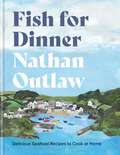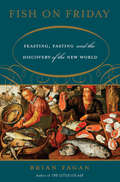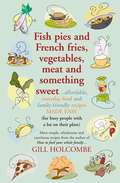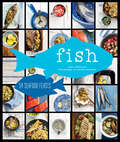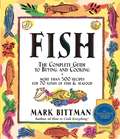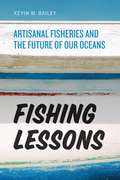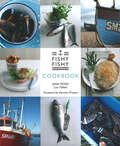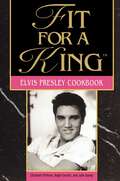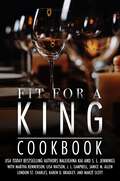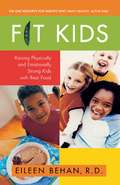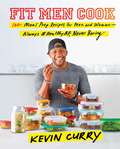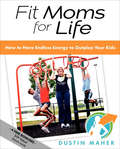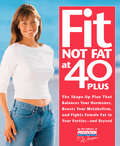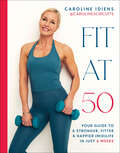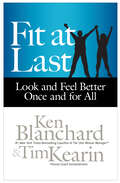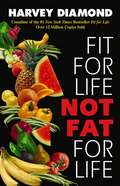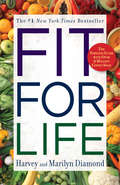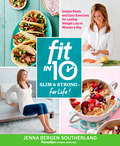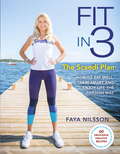- Table View
- List View
Fish for Dinner: Delicious Seafood Recipes to Cook at Home
by Nathan Outlaw'Simply delicious recipes by the master of fish.' Jamie Oliver'No one cooks fish like Nathan, one of the most talented chefs in the UK. This book brings all his talent to the home cook.' Angela HartnettA BRAND NEW collection from the UK's most celebrated fish chef that explains what fish to cook and how to cook it, and provides tasty and inspiring ways to cook seasonal and sustainable fish for dinner.In Fish for Dinner, Michelin-starred seafood chef Nathan Outlaw gives his expert advice on what fish to cook and how to cook it, alongside more than 70 of his best seafood recipes. With illustrated preparation techniques, all of Nathan's top tips and species substitutes for every recipe, it is easy to cook delicious fish at home. From hearty stews to delicate soups, moreish snacks to perfect pan-fried dinners and super seafood salads to smoky barbecue specials, there is a fish dish for every occasion.
Fish on Friday: Feasting, Fasting, and the Discovery of the New World
by Brian M. FaganWhat gave Christopher Columbus the confidence in 1492 to set out across the Atlantic Ocean? Fish on Friday tells the story of the discovery of America as a product of the long sweep of history: the spread of Christianity and the radical cultural changes it brought to Europe, the interaction of economic necessity with a changing climate, and generations of unknown fishermen who explored the North Atlantic in the centuries before Columbus. A fascinating and multifaceted book, Fish on Friday will intrigue everyone who wonders how the vast forces of climate, culture, and technology conspire to create the history we know.
Fish pies and French fries, Vegetables, Meat and Something Sweet: Affordable Everyday Food And Family-friendly Recipes Made Easy (for Busy People With A Lot On Their Plate)
by Gill HolcombeCooking dinner on a daily basis can be tricky. Add shortage of time, lack of inspiration, spiralling food prices and a fussy little eater (or two) to the mix and it seems practically impossible. But the good news is there are still dozens of wholesome, tasty, tried and tested recipes for you and your family to enjoy without breaking the bank or spending too much time shopping and cooking. This book is full of economical, uncomplicated everyday recipes and tips for busy people everywhere - so if you've got LESS money than sense, help is at hand.
Fish pies and French fries, Vegetables, Meat and Something Sweet: Affordable, everyday food and family-friendly recipes made easy
by Gill HolcombeCooking dinner on a daily basis can be tricky. Add shortage of time, lack of inspiration, spiralling food prices and a fussy little eater (or two) to the mix and it seems practically impossible. But the good news is there are still dozens of wholesome, tasty, tried and tested recipes for you and your family to enjoy without breaking the bank or spending too much time shopping and cooking. This book is full of economical, uncomplicated everyday recipes and tips for busy people everywhere - so if you've got LESS money than sense, help is at hand.
Fish: 54 Seafood Feasts
by Cree LeFavourThis James Beard Award–finalist cookbook features more than 120 recipes for fifty-four delectable seafood feasts from culinary traditions across the globe.In Fish, acclaimed cookbook author Cree LeFavour celebrates the versatility, ease of preparation, and healthfulness of fish and shellfish. Five chapters are organized by flavor profile, including American, Bistro, Latin, East and South Asian, and North African/Mediterranean. The recipes are grouped into complete meals featuring a main course of fish or shellfish with a complementary grain, pasta, salad, or vegetable.Fish encompasses all of the best techniques for cooking seafood perfectly, including grilling, roasting, salt-crusting, and wok-braising. All feature sustainable seafood, these exciting recipes make the most of one of the world’s healthiest proteins, suggesting a year’s worth of meals for cooks of all skill levels.
Fish: The Complete Guide To Buying And Cooking
by Mark Bittman Dennis M. GottliebFish: The Complete Guide to Buying and Cooking is a book that simplifies, once and for all, the process of preparing fish. Organized in an easy-reference, A-Z format, Fish gives you the culinary lowdown on seventy kinds of fish and shellfish commonly found in American supermarkets and fish stores. Each entry describes how the fish is sold (fillets, steaks, whole, salted), other names it goes by, how the fish should look, and buying tips. Fish begins with general guidelines on how to store, prepare, and cook fish, whether sauteing, frying, grilling, or smoking, and you will find easy-to-follow illustrations of such important basics as how to gut and fillet a fish. Fish also includes up-to-the-minute information on the health benefits of fish in our diet. In addition, there are more than five hundred recipes and variations, all of which use low-fat, high-flavor ingredients to accent the intrinsic natures of the individual fish rather than mask them. And the vast majority of the recipes are ready in less than thirty minutes.
Fishing Lessons: Artisanal Fisheries and the Future of Our Oceans
by Kevin M. BaileyFish bones in the caves of East Timor reveal that humans have systematically fished the seas for at least 42,000 years. But in recent centuries, our ancient, vital relationship with the oceans has changed faster than the tides. As boats and fishing technology have evolved, traditional fishermen have been challenged both at sea and in the marketplace by large-scale fishing companies whose lower overhead and greater efficiency guarantee lower prices. In Fishing Lessons, Kevin M. Bailey captains a voyage through the deep history and present course of this sea change—a change that has seen species depleted, ecosystems devastated, and artisanal fisheries transformed into a global industry afloat with hundreds of billions of dollars per year. Bailey knows these waters, the artisanal fisheries, and their relationship with larger ocean ecology intimately. In a series of place-based portraits, he shares stories of decline and success as told by those at the ends of the long lines and hand lines, channeling us through the changing dynamics of small-scale fisheries and the sustainability issues they face—both fiscal and ecological. We encounter Paolo Vespoli and his tiny boat, the Giovanni Padre,in the Gulf of Naples; Wenche, a sea Sámi, one of the indigenous fisherwomen of Norway; and many more. From salmon to abalone, the Bay of Fundy to Monterey and the Amazon, Bailey’s catch is no fish tale. It is a global story, casting a net across waters as vast and distinct as Puget Sound and the Chilean coast. Sailing across the world, Bailey explores the fast-shifting current of how we gather food from the sea, what we gain and what we lose with these shifts, and potential solutions for the murky passage ahead.
Fishing for Trouble (An Alaskan Diner Mystery #2)
by Elizabeth LoganSomething fishy is going on at a local seafood processing plant, and Charlie Cooke is on the hook to solve the case in this new Alaskan Diner Mystery.Summer has come to Elkview, Alaska, bringing twenty hours of sunlight every day, not to mention a surge of tourists and seasonal workers. Chef Charlie Cooke is eager for a busy yet relaxing season, but when a young man working a summer job at the local fish processing plant dies moments after walking into the Bear Claw Diner, she&’s quickly swept into the investigation.Soon, through her best friend Annie Jensen, Charlie learns that another student worker at J and M Processing has disappeared, leaving more questions and fewer answers. The near-endless sunlight gives plenty of time to search for clues, but Charlie will have to work with Annie and local reporter Chris Doucette to net the killer before anyone else gets hurt.
Fishy Fishy Cookbook
by James Ginzler Loz TallentThe creators of Brighton’s beloved seafood brasserie share the wisdom, secrets, and recipes behind their delectable, sustainable fare.Fishy Fishy, the relaxed seafood brasserie in Brighton, England, was the brainchild of three close friends: James Ginzler, Dermot O'Leary and Paul Shovlin. They share a passion for good food that has been locally and responsibly sourced. There’s no cod on the summer menu or lobster in winter—such is their commitment to serving what’s in season.Now they’ve packed all their passion and expertise into the Fishy Fishy Cookbook. This volume features more than ninety recipes, as well as fascinating fish facts and plenty of advice on how to prepare and cook fish. With chapters on Starters, Barbecue & Alfresco Eating, Everyday Fish & Shellfish, Special Occasions, Sauces, Side Dishes & Desserts, there is plenty of inspiration for cooks of all levels. More than just a restaurant cookbook, the authors share a timely look at best practices for sourcing and eating fish.
Fit For A King: The Elvis Presley Cookbook
by Elizabeth MckeonKitty Dolan recalls a visit with Elvis in Killeen, Texas, right after his mother's death. "We drove in Elvis's white Cadillac to the house they had rented from Judge Crawford. . . .That night we sat down to dinner, with Elvis at one end of the table and his father at the other. Then his grandmother. There was a big platter of white bread for sandwich makings and a big platter of southern baked beans. Theat was topped off with a delicious pie his Grandmammy had baked. Elvis looked at me with a shy, little smile and said, 'I hope you like our southern cooking.'"Elvis Presley liked traditional southern cooking. In Fit for a KingTM are more then 300 recipes for the foods Elvis enjoyed, including many from his longtime cook Alvena Roy. Also included are menus for meals served at Graceland, for Elvis and Priscilla's wedding reception, for the Beatles' visit, and for Christmas in Memphis.The memories Elvis's friends have of mealtimes with him at Graceland depict him as a thoughtful, considerate, and fun-loving person. Many of the seventy photographs are published here for the first time.
Fit For a King
by Naleighna Kai Lisa Watson Shakir Rashaan S. L. Jennings Martha Kennerson Terri Ann Johnson London St. Charles Anita L. Roseboro MarZe Scott J. L. Campbell Janice M. Allen Michelle D. Rayford Stephanie M. Freeman Vanessa Riley Aiken Ponder Florenza Denise Lee Karen Bradley Vikkas Bhardwaj Laverne Thompson Chandra Sparks SplondThis cookbook, created by New York Times, USA TODAY, and National Bestselling Authors, is inspired by the Kings of the Castle Standalone Series. It contains an interesting mix of cuisines from India, Italy, Southern USA, Africa, and many other places. Several authors from the series and their friends, have shared everything from childhood favorites to main meals that are sure to please the most discriminating tastebuds. Also, there are excerpts of their latest books and free books for you to enjoy!
Fit God's Way: Your Bible-Based Guide to Food, Fitness, and Wholeness
by Kim Dolan LetoAn ESPN Fitness America Champion provides a step-by-step, God&’s Word-based guide to equip Christian women with solutions to gain control of over food, find lasting motivation to workout, confidently seem themselves through God&’s eyes, and live their best life.If you&’re tired of starting your diet over every Monday, if getting dressed stresses you out, if scrolling through your social media feed makes you feel insecure, this is not of God! The way the world portrays health, fitness, and body confidence causes us to live in a thought cycle of &“not good enough&” and defeat, but in Christ we are free to live boldly as the best version of ourselves. If you&’re a Christian woman who loves Jesus and fitness, but you haven&’t been able to get fit or find confidence, this Word-based solution is your answer. An empowering Christ-centered system that exchanges the lies of the world for the truth of God is the answer you will find in this book. It&’s time to trade relying on weak willpower for the Holy Spirit gift of self-control, lasting motivation found in your purpose, and confidence found seeing yourself through His eyes! Yes, you can cross the finish line of your goals. You just need your secret recipe! Fit God&’s Way provides the necessary tools you need to create your personalized daily system of success through the 5 Pillars of Christ-Centered Fitness. If you know in your heart that you were made for more than failed diets and feeling less than… and you are ready to dare to believe with boldness you can become God&’s best version of yourself, it&’s time to live Strong. Confident. His.
Fit Gurl: The Total-Body Turnaround Program
by Melissa AlcantaraA USA TODAY BESTSELLER"Melissa pushed me...Once I started to work out with her I realized, this is way harder than I thought it would be."—KIM KARDASHIAN WESTA FITNESS PROGRAM WITH SERIOUS RESULTS DESIGNED BY KIM KARDASHIAN WEST'S MOST CELEBRATED PERSONAL TRAINER, MELISSA ALCANTARA, AKA @FITGURLMEL What do you want? To have biceps, a butt, and defined abs? To wear anything? To feel resilient and capable?These things are about one thing: work. If you’re ready to put in the time, commitment, and dedication, Fit Gurl will change your body and your life.Fit Gurl features:Melissa's day-by-day 'Turnaround' program that worked for her and will work for youMelissa’s unbelievable story of transformation, going from post-pregnancy, fitness newbie to shredded athlete and full-time personal trainerOver 40 recipes for healthy meals, smoothies, and sides including poke bowls, pancakes, and moreThis isn’t just about your body. Fit Gurl is a path to self-discovery through fitness and a plan for going from one way of life to another with purpose and intention. Melissa did it and so can you.
Fit Kids
by Eileen BehanWhat and how you feed your family is an important issue for every child, no matter what their weight. Being overweight is a potentially serious health problem, but the overweight child who obtains family support, adopts a healthy eating pattern and exercises will be healthier than the normal child who does not receive such attention. Parents need to protect their children from advertising messages that tell them life will be better if they EAT, EAT, EAT. The goal of this book is to provide parents with tools they will need to guide their child to natural, gradual weight loss. These tools consist not only the facts about weight loss, but also what leads to success. So, do read this book if you wish to help your child and guide him or her towards a healthier way of life.
Fit Men Cook: 100+ Meal Prep Recipes for Men and Women—Always #HealthyAF, Never Boring
by Kevin CurryThe fitness influencer and creator of the #1 bestselling Food & Drink app, FitMenCook, shares 100 easy, quick meal prep recipes that will save you time, money, and inches on your waistline—helping you to get healthy on your own terms.We like to be inspired when it comes to food. No one enjoys cookie-cutter meal plans, bland recipes, or eating the same thing every day. Instead of worrying about what to eat and how it’s going to affect our bodies, we should embrace food freedom—freedom to create flavorful meals, but in a more calorie-conscious way; freedom to indulge occasionally while being mindful of portions; and freedom to achieve wellness goals without breaking the bank. In Fit Men Cook, Kevin Curry, fitness expert and social media sensation with millions of followers and hundreds of thousands of downloads on his app, shares everything you need to live a healthy life each day—from grocery lists to common dieting pitfalls to his ten commandments of meal prep—as well as his personal story of overcoming depression and weight gain to start a successful business and fitness movement. This guide also includes 100+ easy and flavorful recipes like Southern-Inspired Banana Corn Waffles, Sweet Potato Whip, Juicy AF Moroccan Chicken, and many more to help you plan your week and eat something new and nutritious each day. With Fit Men Cook, you can create exciting, satisfying meals and be on your way to losing weight for good. After all, bodies may be sculpted at the gym, but they are built in the kitchen.
Fit Moms for Life: How to Have Endless Energy to Outplay Your Kids
by Dustin MaherGet to know thirty-one amazing women who have taken the Fit Mom for Life Challenge, dropped up to a hundred pounds—and kept it off! Are you ready to look twenty years younger? Have a flat stomach again? Take your husband&’s breath away each time he sees you? Bring sexy back into being a mom? Melt the muffin top? Fit into your skinny jeans and still have room left over? Be a mom that your kids are proud of? In this book you will discover: One exercise that can make your stomach 2–4 inches smaller within two weeksThe workout that can burn off far more fat than doing boring cardioHow to burn fat 24 hours a dayHow to eat like a linebacker and have a metabolism of a hummingbirdHow to change your thoughts to produce lasting results Dustin Maher, a self-proclaimed &“Mama&’s Boy&” who has given his life to serving moms and helping them look and feel their best, asks &“Who is taking care of you?&”—and shows why moms must start putting themselves first in order to be there for the ones they love.
Fit Not Fat at 40-Plus: The Shape-Up Plan that Balances Your Hormones, Boosts Your Metabolism, and Fight s Female Fat in Your Forties-- and Beyond
by Prevention Health Books for Women"If I have to listen to one more 18-year-old in a leotard telling me to 'work it harder,' I'm going to scream!"Finally, a fitness plan for real women!Aerobo-bunnies got you down? In the high-impact world of extreme diet and fitness guides, those of us over 40 can sometimes seem left behind.Well, no more. Finally, there's a weight-loss guide for real women.Fit Not Fat at 40-Plus is the only diet and fitness guide that has analyzed the complex roles of metabolism, hormone changes, physical challenges, and stress in women's post-40 weight gain, and devised a quick-start, easy follow-through plan for immediate results. You will:Never get bored again! Sample hundreds of exciting new exercises, 10-minute workouts, motivational secrets, and insider tricks, everything from how to remain sweat-free to how to look like a pro at your first African dance or yoga class.Boost your metabolism around the clock! More than 100 step-by-step photos of easy-to-follow muscle-building exercises show you how to boost your calorie-burning power by 15 percent-- an extra 300 calories a day--even when you're sleeping!Banish pain and discomfort! Choose from more than 25 specific fitness prescriptions to help relieve everything from asthma and diabetes to osteoporosis and rheumatoid arthritis.Blast cravings and eat all day! Build your 40-Plus Eating Plan around mouthwatering recipes, 14 days of interchangeable meal plans, and the only diet you'll ever need to lose weight, prevent disease, and manage your blood sugar, designed by a dietitian from the Joslin Diabetes Center of Harvard University.Kick your feet up--and lose even more weight! Learn why destressing is your new mandatory weight-loss strategy, and choose from 50 luxurious mini-escapes in the Relax and Recharge Plan-- because you deserve it!In just 1 week, you'll be on your way to shedding pounds, years, and worries. Leave the sweating, injuries, and fad-diet frustrations to those aerobo-bunnies--this plan is for you!
Fit at 50: Your Guide to a Stronger, Fitter, and Happier (Mid) Life in Just 6 Weeks
by Caroline IdiensFollow personal trainer and influencer, Caroline Idiens’ six-week program, designed to help you get Fit at 50.With week-by-week, full-body strength-based workouts, accompanied by 60 recipes developed with a registered dietitian specializing in women’s health, Fit at 50 will help you get stronger, fitter, and healthier in just six weeks. Caroline’s 360-degree program will help you establish your fitness goals, progressively build up to longer workouts, and continue your fitness for decades to come. Caroline Idiens is a woman on a mission – a mission to show you that midlife can be the best time in a woman’s life. She has already helped thousands of women transform their fitness, confidence, and mid(life), with her global online members program Caroline’s Circuits, and with Fit at 50 she can help you do the same.
Fit at Last: Look and Feel Better Once and for All
by Ken Blanchard Tim KearinIf you’re like a lot of us, for years you’ve been making resolutions and promises about becoming physically fit. Despite all your good intentions, though, somehow it never quite goes according to plan. But you can break that cycle.In Fit at Last, bestselling business author Ken Blanchard and fitness authority Tim Kearin show how Ken, at age seventy-three, finally was able to make lasting improvements in his health and fitness, including dropping over thirty pounds in a year. In each chapter, Ken shares the very personal story of his ups and downs—involving, among other things, a puppy, a Hawaiian tour bus full of widows, and a fifty-year college reunion—while Tim offers expert advice and wisdom gained from over forty years in the fitness industry.Following through on your efforts to get fit requires leadership—personal leadership. Early on, Ken realized the same concepts he’d been using for years to help people lead organizations also could help him stick to his program. Here, you’ll learn how Ken and Tim applied the Situational Leadership II approach to set SMART goals, diagnose Ken’s progress in each of the six core areas of fitness, and match them with the leadership styles necessary to get Ken to the next level in each area. Certainly there is a wealth of excellent fitness advice here—but ultimately, this is a book about commitment. People don’t fail because they don’t know what to do—they fail because they just don’t do it. Using the tools in this book, you’ll be able to move from simply being interested in fitness to making a lasting commitment—one that will add a spring to your step, a smile to your face, and years to your life.
Fit for Life, Not Fat for Life
by Harvey DiamondThere is only one concept to grasp and only one action to take: Eat more living food than dead food.
Fit for Life: Not Fat for Life
by Harvey DiamondThere is only one concept to grasp and only one action to take: Eat more living food than dead food. The simplicity of this message has eluded people up to now. In fact, it may seem oversimplified. Because of past frustrations and disappointments, people have come to believe that losing weight is complicated, difficult and expensive. Truth be told, all that is required to reap the myriad benefits of Harvey Diamond's program is to return to the fundamentals of life. The human body is intelligent and capable beyond anyone's comprehension, but in order to unleash this extraordinary intelligence-including that which normalizes body weight-the proper fuel is required. That fuel is living food. But for some inexplicable reason, people have allowed themselves to believe that they can give their bodies the wrong fuel and then have it operate at optimum efficiency. And that is why most people become overweight. This book offers not a diet, but a lifelong way of eating that allows the eating experience to remain a joyous one, rather than a clinical endeavor of measuring portions, counting calories, calculating grams of fat, carbohydrates and protein, or ingesting meal replacements. It teaches readers how to eat any food in the most healthful way so there is no feeling of deprivation. As readers embark on this life-changing journey, they will experience the surge of energy and well-being that only comes as the automatic result of properly fueling their bodies. Providing deliberate, gentle and forgiving guidance every step of the way, this book will become readers' trusted source and companion as they create a new way of eating and living, which will lead to both overweight and poor health becoming conditions of the past.
Fit for Life: Votre Poids Santé Pour La Vie (Pathway Ser.)
by Harvey Diamond Marilyn DiamondDiscover why Fit for Life's easy-to-follow weight-loss plan has made this enduring classic one of the bestselling diet books of all time! It's the program that shatters all the myths: Fit for Life the international bestseller that explains how to change both your figure and your life. Nutritional specialist Harvey and Marilyn Diamond explain how you can eat more kinds of food than you ever ate before without counting calories...and still lose weight! The natural body cycles, permanent weight-loss plan that proves it's not only what you eat, but also when and how, Fit for Life is the perfect solution for those who want to look and feel their best. Join the millions of Americans who are Fit for Life and begin your transformation with: The vital principles that bring you permanent weight loss and high energy The Fit for Life secrets of timing and food combining that work with your natural body cycles A 4-week meal plan, menus, shopping tips, and exercise Delicious recipes and more.
Fit in 10: Simple Meals and Easy Exercises for Lasting Weight Loss in Minutes a Day
by Jenna Bergen SoutherlandBased on the successful video franchise from Prevention, Fit in 10 is a plan for even the busiest woman: exercise for 10 minutes per day and prep clean recipes in 10 minutes or less.Most women already know, more or less, what they should be doing to keep their bodies healthy and strong. Eat right, work out, and be mindful—but who really has the time for all of that when work is crazy, the kids are waiting for dinner, and there just aren’t enough hours in the day? It turns out, you don’t need hours: just 10 minutes!Based on cutting-edge research and designed for real women, the 60-day Fit in 10 plan offers proven results without endless hours at the gym or cooking elaborate meals. Working out for just 10 minutes per day and spending 10 minutes or less creating healthy, delicious meals will result in a faster metabolism, slimmer waistline, reduced pain, and overall improved health and mood. Fit in 10 is a lifestyle, not a diet. Prevention has developed this program to help you boost your commitment to a healthy, active life. The book includes a 10-day clean-eating jumpstart meal plan; 85 healthful, delicious recipes; and a 60-day training plan to help you form new exercise and eating habits that will improve your health and tone and tighten your body. The 10-minute “Life Changers” throughout the book encourage and empower you to prioritize yourself and stay on track to meet those goals long past the first 60 days.
Fit in 3: How to Eat Well, Train Smart and Enjoy Life The Swedish Way
by Faya NilssonThree is the magic number!Change your life for ever with Faya Nilsson's Scandi-inspired, three-week food, fitness and mindfulness plan. With 60 delicious, healthy recipes.'During my career as a personal trainer, I've helped hundreds of clients arm themselves with the knowledge to achieve a happy, healthy and balanced life - with minimum sacrifice. FIT IN 3 will empower you to do the same.'Inspired by her childhood in rural Sweden - where fresh ingredients, fresh air and freshly baked cakes were a fundamental part of everyday life - personal trainer and award-winning blogger Faya Nilsson has created FIT IN 3. In this essential guide, the three key elements of a healthy life - food, fitness and mindfulness - work in harmony in a way that will change how you think about your mind and body for ever.With 60 easy-to-make, healthy recipes that don't skimp on fun or flavour (including some Scandi favourites!), calming mindfulness and yoga routines to help ease even the most over-stressed minds and highly effective, time-efficient workouts that don't require a gym membership, FIT IN 3 provides you with a simple formula for an enjoyable, healthy life. It's as easy as 1, 2, 3!To get you started on your journey, FIT IN 3 includes a three-week plan with daily menus, step-by-step HIIT and bodyweight-resistance workouts - suitable for beginners - and mindfulness exercises. It's everything you need to kick-start a new and sustainable way of life. 'You don't need to be fit already, you don't need to spend a fortune, you needn't be twenty-something years old and (crucially) you don't need to give up chocolate! Anyone can participate, and this book with provide you with the fundamental knowledge to understand how to do it forever. Let's get started!'Faya x
Fit in 50 Days: Creating the Habits that will Keep You Lean for Life
by Martin BrownIn 50 days, you can change your life forever. You can create the healthy habits that will keep you lean for life. And, you can do it all in just seven weeks and a day. Most importantly, you can put an end to yo-yo dieting, and the unhealthful cycle of getting in and out of being fit.Getting fit -- and staying fit -- is considered by most of us to be a wonderful but unattainable goal. Fit in 50 Days disproves that idea. This is a step-by-step, day-by-day program that is rooted in the common sense realities of how we live now. In each passing year, as we continue to consume more calories and have fewer physical demands put upon us, inevitably our weight will rise. The simple arithmetic of calories consumed and calories burned comes easily. The really tough part is finding lasting solutions to this problem.Even with the defeat of once deadly infectious diseases, overall health outcomes in today's culture are abysmal. Through technology and modern medicine we have managed to expand life spans, but our health spans, the years we experience general good health, are considerably shorter: a situation that most of us would agree is the least desirable, living a longer unhealthy life.You can take control of your own health now with this easy-to-adopt and easy-to-follow fitness plan. It is the single most important thing you can do to help assure that in the future you will not be one of the living sick. And if your health is already compromised Fit in 50 Days can be an essential tool to restoring your health and vitality. This program creates a framework in which you can shape your own specific performance level. That's why Fit in 50 Days works for all ages and stages of life.Remember that lasting fitness is far more than a New Year's resolution. Diet and exercise are of equal importance and that is why Fit in 50 Days devotes equal attention to both subjects. Successful diets that allow you to quickly lose extra pounds should never be a detour around your usual diet. Lasting fitness is a habit, and in just 50 days, this program will change your view of diet and exercise forever.If you're ready for a new and successful direction, then you're ready for the daily lessons of Fit in 50 Days. If you thought that lasting weight loss was not possible, you're in for a wonderful surprise. You'll be equally amazed that with focus and simple exercises your body will quickly begin to improve and strengthen. Today, whether you're twenty-one or seventy-one, there's a good chance you have not taken full advantage of the marvelous gift that is your body. Fit in 50 Days will change all that as you learn to leave bad dietary habits behind, grow stronger and more flexible, reset your health priorities, and experience the joy that comes when you feel yourself growing stronger with each passing day.If you're ready for this journey, buy Fit in 50 Days NOW and claim the more active life and better health you deserve.
